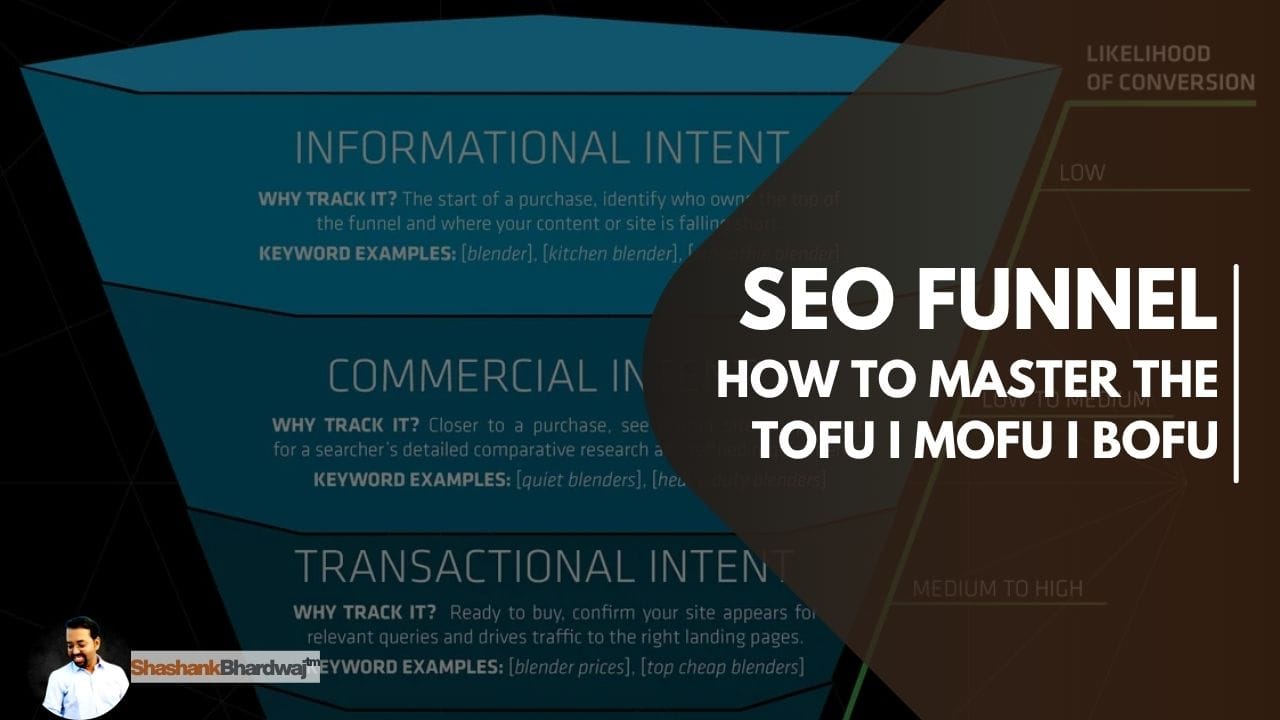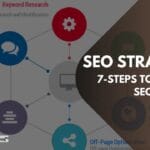Let’s be honest. When you hear “SEO,” what comes to mind?
If you’re like most of us, you probably picture a frantic scramble for keyword rankings, a technical nightmare of site speeds and meta tags, or a content mill churning out article after article hoping something sticks.
I get it. For years, I saw SEO that way too—a disjointed set of tasks. That was until a fundamental shift in my perspective completely changed the game. I stopped thinking about SEO as a collection of tricks and started seeing it for what it truly is: a journey.
Imagine a real, physical funnel. Wide at the top, narrow at the bottom. Now, picture your potential customers entering at the top. Your job isn’t just to get them in; it’s to guide them smoothly down through the narrow spout, where they emerge as happy, paying customers.
This, my friends, is the SEO Funnel.
And understanding its three core stages—affectionately known as TOFU, MOFU, and BOFU—is the secret to transforming your SEO from a cost center into a revenue-generating machine. This isn’t just theory; it’s a practical, actionable framework that answers the most crucial question: “What should I write about, and for whom?”
So, grab a coffee, get comfortable, and let’s demystify the journey that turns casual searchers into loyal customers.
The SEO Funnel Isn’t Complicated: Let’s Meet TOFU, MOFU, and BOFU
At its heart, the SEO Funnel is just a map of your customer’s mindset. It recognizes that someone just discovering they have a problem is in a completely different headspace than someone ready to pull out their credit card.
Trying to talk to both of them with the same content is like using a megaphone to have a intimate conversation—it’s loud, annoying, and utterly ineffective.
Let’s break down each stage, and I promise to keep the jargon to a minimum.
TOFU (Top of Funnel): The “What Is This?” Stage
- User’s Mindset: Curious, exploratory, unaware. They’ve just encountered a problem or a concept and are starting to look into it.
- The Core Question They’re Asking: “What is [this problem]?” or “Why is [this concept] important?”
- Your Content’s Goal: Pure awareness. You’re not selling here. You’re helping, educating, and building trust. You’re the friendly expert on the block.
Imagine this: Someone types “why are my houseplants’ leaves turning yellow” into Google. They aren’t looking to buy a specific brand of fertilizer; they’re trying to understand the problem. Your TOFU content is the comprehensive blog post that explains all the potential causes—overwatering, insufficient light, nutrient deficiency.
Content Formats for TOFU:
- Informative Blog Posts & Articles
- “What is…?” Guides
- Listicles (“5 Signs You’re Overwatering Your Plants”)
- Explainer Videos
- Infographics
MOFU (Middle of Funnel): The “How Do I Solve This?” Stage
- User’s Mindset: Research-oriented, evaluative. They understand their problem and are now actively looking for solutions. They’re comparing options.
- The Core Question They’re Asking: “What’s the best solution for my situation?” or “How do [Solution A] and [Solution B] compare?”
- Your Content’s Goal: To position yourself as the best solution. You’re providing deeper, more comparative information that helps them make an informed choice.
Back to our example: Our plant parent now knows yellow leaves can mean a nutrient issue. Their search evolves to “organic plant fertilizer vs. synthetic plant fertilizer” or “best fertilizers for indoor succulents.” They are in research mode.
Content Formats for MOFU:
- In-depth Comparison Guides (A vs. B)
- Case Studies & Success Stories
- Webinars
- Product Comparison Charts
- Detailed “How-To” Guides that involve your solution area.
BOFU (Bottom of Funnel): The “Which One Should I Buy?” Stage
- User’s Mindset: Decision-ready, high-intent. They’ve done their research, they know what they need, and they’re ready to make a purchase.
- The Core Question They’re Asking: “Should I buy [Your Product] or [Competitor’s Product]?” or “Is [Your Product] worth the money?”
- Your Content’s Goal: To remove final objections and compel action. This is where you make your case and close the deal.
Our plant enthusiast is now ready. Their searches are hyper-specific: “[Your Brand] Organic Fertilizer reviews,” “[Your Brand] vs. [Competitor Brand],” or “buy organic plant fertilizer near me.” They have their wallet out.
Content Formats for BOFU:
- Free Trials & Demos
- Customer Testimonials & Review Roundups
- Detailed Product Pages & Spec Sheets
- “Why Us?” Pages
- Coupon Codes or Special Offers
Here’s a quick table to visualize the whole journey:
| Funnel Stage | What It Stands For | The User’s Burning Question | Your Goal |
|---|---|---|---|
| TOFU | Top of Funnel | “What is this and why should I care?” | Build Awareness & Trust |
| MOFU | Middle of Funnel | “What’s the best way to solve this?” | Showcase Your Solution |
| BOFU | Bottom of Funnel | “Which specific option should I buy?” | Drive the Purchase |
The Secret Sauce: Why You Should Build Your SEO Funnel Backwards (The “Bottom-Up” Strategy)
Now, here’s where most businesses get it wrong. The intuitive approach is to start at the top: build a huge audience with TOFU content and hope some trickle down to become customers.
It sounds logical, right? Fill the top, and the bottom will eventually fill up.
But I’m here to tell you to flip that entire model on its head. The most effective, revenue-smart way to build your SEO Funnel is from the bottom-up.
Why? Because it prioritizes immediate business impact over vanity metrics.
Think about it. If you only have limited time and resources (and who doesn’t?), where would you get the biggest bang for your buck? On the person vaguely curious about your industry, or the person actively ready to buy what you sell?
The answer is obvious. So, let’s talk about the strategic sequence.
Step 1: Start with BOFU – Secure the Buyers First
Your very first content priority should be to capture the users who are already at the finish line. These are the people searching for your product, your brand, or direct comparisons.
The Rationale: By creating stellar BOFU content—crystal-clear product pages, compelling case studies, robust FAQ pages—you are plugging the biggest hole in your revenue bucket. You’re converting the traffic you could be getting into actual, paying customers. This generates immediate ROI and, crucially, provides the revenue to fund the rest of your content efforts.
Step 2: Move to MOFU – Educate the Researchers
Once you’ve built a solid foundation for converters, it’s time to cast a wider net for those in the consideration phase. These people know they have a problem and are evaluating their options, but they might not know you exist.
The Rationale: Now, you create content that intercepts these researchers. When you rank for “best solution for X” or “A vs. B,” you insert your brand into their consideration set. You’re not just capturing demand; you’re influencing it. You demonstrate your expertise and gently guide them from your MOFU content directly to your BOFU pages, nurturing them toward a decision.
Step 3: Finish with TOFU – Become the Trusted Authority
Finally, with a system in place to convert and nurture, you can focus on the top of the funnel. This is where you build brand awareness and authority on a massive scale.
The Rationale: TOFU content is often a long game. It builds your reputation, attracts backlinks, and creates a steady stream of new visitors. While these visitors aren’t ready to buy today, you’re planting the seed. By being the source of their initial education, you ensure that when their problem becomes urgent, they remember you and enter your funnel, not your competitor’s.
This Isn’t Just Theory: It Works in the Real World
I once worked with an SEO client who was stuck. They had decent domain authority but their traffic and conversions had plateaued. We implemented this exact “bottom-up” strategy.
Our first six months were laser-focused on a “BOFU Content Focus.” We audited and optimized every product page, created detailed comparison pages against their main competitors, and gathered every testimonial we could find. We made it as easy as possible for a ready-to-buy customer to choose them.
Then, and only then, did we shift to creating “New MOFU Content.” We built out comprehensive buying guides and solution-based articles that answered the “how to choose” questions.
The results weren’t just better rankings. In six months, we grew their top 3 rankings from 55 to over 275. But the metrics that really mattered?
- Traffic skyrocketed from 38K to 70K—an 84% increase.
- Impressions grew by 67.6%.
- Most importantly, revenue followed suit, seeing a dramatic uptick as we systematically removed friction from the customer’s journey.
We secured the bottom of the funnel first, and the entire business ecosystem became stronger because of it.
Your Key Takeaways: The SEO Funnel in a Nutshell
If you take only three things from our conversation today, let it be these:
- SEO is a Funnel, Not a Scattergun. Remember the three stages: TOFU (Awareness), MOFU (Evaluation), and BOFU (Decision). Create content that specifically matches the user’s intent at each stage.
- Build Backwards for Forward Momentum. The most strategic order for content creation is BOFU -> MOFU -> TOFU. Prioritize capturing high-intent buyers before spending heavily on top-of-funnel awareness.
- Revenue Fuels Reach. This bottom-up strategy works because it focuses on securing paying customers first. This provides the vital revenue and data to then confidently invest in building broader, long-term awareness. It’s a sustainable, self-funding growth model.
Mastering the SEO Funnel is about empathy. It’s about stepping into your customer’s shoes and asking, “What do I need right now on my journey?” When you answer that question with the right content, at the right time, you stop chasing algorithms and start connecting with people.
And that, ultimately, is what drives real, lasting growth.
Now, I’d love to hear from you! Which part of your funnel needs the most attention right now? Are you neglecting your BOFU, or is your TOFU content not attracting the right crowd? Let me know in the comments


